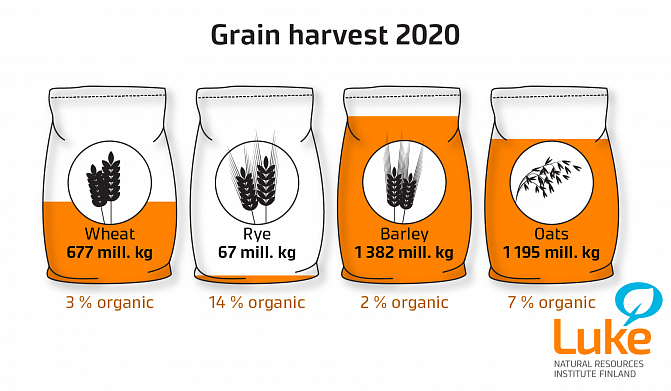The 2020 cereal harvest was one tenth lower than on average – is it sufficient to meet our demands?
The cereal harvest of approximately 3.3 million tons was relatively low. It was one tenth lower than on average during the past ten years. The cereal harvest is primarily sufficient to meet our annual domestic consumption, but it cannot fully satisfy all our needs.
“Rye remained the weakest link in the cereal harvest, and its yield cannot cover our annual demand for rye. However, there will be no shortage of domestic rye because the previous year’s rye yield was record high”, says Anneli Partala, senior statistician at the Natural Resources Institute Finland (Luke).
The rye harvest fell
The rye yield harvested during the autumn of 2020 is sufficient to cover our calculated eight-month consumption, that is, until April 2021. The missing four months, meaning the period before next harvesting, does not, this time, automatically mean that rye needs to be imported, as the high rye harvest in 2019 equalled our consumption of two years. The 2019 rye harvest has been stored by domestic mills, traders and farms. This means that the rye yield is sufficient for the new harvest next autumn.
What is the rye situation expected to be next autumn?
Can we count on the sufficiency of domestic rye next autumn? No, we cannot, as the area sown with rye last autumn, meaning the rye growing next summer, was fairly small. Only excellent harvest levels next autumn could guarantee the sufficiency of rye for the year following harvesting: from the autumn of 2021 until the autumn of 2022. Instead, if the 2021 rye harvest is low, the harvest level may be the lowest in decades.
Although rye is the dearest cereal in the hearts of many Finns in the form of rye bread, a popular favourite, its domestic production is not guaranteed every year. Many farmers would blame this on the low price paid for rye in addition to difficult sowing conditions.
Oats were the only cereal with an increase in harvest levels
The oat harvest increased by a few per cent from the previous year, being more than one tenth higher than on average during the past ten years. The harvest level of oats (1.2 million tons) is already fairly close to that of barley, our most sown cereal (1.4 million tons). The last time the oat harvest level was this close to the barley harvest was 30 years ago in 1990, when both recorded excellent yields.
It is no coincidence that oats are gaining on barley. The main reason for the increased popularity of oats can be found from Finnish and non-Finnish tables. Consumers across the world are wanting more oat products to eat and drink. Demand has increased the domestic oat-based food industry and guaranteed a never-ending flow of oats to our ports for delivery overseas.
Oats are our only cereal in the production of which we can proudly say that we are leading countries in Europe. In recent years, Poland has been the largest producer of oats. Finland and Spain have been the two other countries in the TOP-3. Sweden has not made it to the podium in this race of oat production between the EU states. We are also among the top producers on a global scale. In 2019, only Russia and Canada were larger producers of oats than Poland.
What is our most organic cereal?
There could be at least two answers. Measured by quantity, oats have the highest organic production volume of more than 80,000 tons. However, organic oats (only) account for seven per cent of our high oat harvest. Rye could be another answer. Organic rye accounts for 14 per cent, or nearly 10,000 tons, of our total rye production.
Statistics also include conventional production alongside with organic and total production
The database tables of the harvest statistics have been changed. Now, harvest data on conventional produced crops is also available as a new classification alongside with all crops included in the statistics. Another significant change was the inclusion of organic statistics in the harvest statistics. As a result, it is now even easier in the new harvest statistics to compare organic statistics with Finland’s total production and conventional production, and the other way round.
Background to the statistics
Luke collected crop production information from approximately 6,200 farms, of which 700 were organic farms, using telephone interviews and an online survey. The harvest statistics consist of information obtained from approximately 5,600 farms. Information about the quality of the cereal harvest has been compiled by combining the crop production information collected by Luke and the Finnish Food Authority’s cereal quality monitoring information.
All information is available in the stat.luke.fi service. The service includes crop production information about key crops in all parts of Finland starting from 1920, and organic information starting from 2006. Regional crop production information is available in the service starting from 1999, and organic information starting from 2014. Conventionally produced crop production information is available in the service starting from 2020.
Statistical publication
See statistics data related to the news in the statistical publication.




